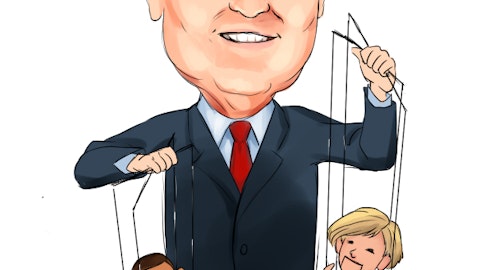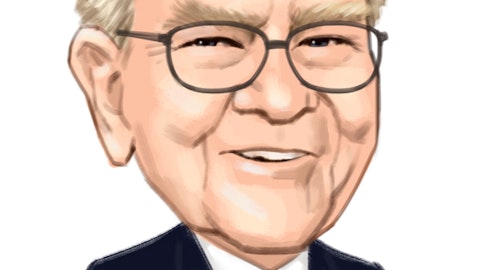Frank Slootman: One follow-on, Kirk. Document AI is a technology that we’ve been working on for quite a while, and it really was on the basis of an acquisition we did over a year ago. That is now going into preview. And it is incredibly popular out there and what Document AI does returns to an unstructured document into a semi-structure document. So it can become a full participant in analytical processing. There is a ton of interest in that. And so that really brings the entire estate of unstructured data, which is 80% of the world’s data into the analytical sphere. So we do expect that to become very important, and especially because AI and LLMs are so heavily focused on unstructured data, textual data, at least today, this will be something that will be a driver in our business.
Kirk Materne: Thanks. And Mike, can you just give us an update on where the federal sort of opportunity stands? I know you guys were waiting to hear back on FedRAMP. Any update on that? Thanks.
Mike Scarpelli: Federal is a huge opportunity, and I would say it’s upside for us because it’s such a small piece, but we should have our FedRAMP high authorization literally any day. I actually thought I might have had it today. So stay tuned. You’ll see an announcement on that very soon.
Kirk Materne: Thanks. Appreciate it.
Operator: Thank you, Mr. Materne. Our next question is from the line of Brad Reback with Stifel. You may proceed.
Brad Reback: Great, thanks very much. Just a quick technical question with Graviton 4 now being announced by Amazon, should we think of any potential headwinds there?
Mike Scarpelli: Well, as we told you before, every year, we count on a 5% headwind associated with software hardware improvements. Graviton 4 was just announced recently. We really have not tested that and not all hardware improvements benefit our software. We expect there will be some, but we just don’t know. It’s too early, stay tuned and we’ll update you when we have more information.
Brad Reback: Great, thanks very much.
Operator: Thank you, Mr. Reback. Our next question is from the line of Alex Zukin with Wolfe Research. Please proceed.
Ethan Bruck: Hey, guys. This is Ethan Bruck for Alex Zukin. Congrats on the nice quarter. My question is, if you’re assuming the consumption trends persist through 4Q, and that’s how you’re guiding, I guess, what would be the biggest puts and takes to accelerate growth next year? And in the same vein, when we think about NRR, just given the stabilizing consumption trends, I guess, directionally, when should we think about when would we expect NRR to stabilize trough and around like what level would you expect?
Mike Scarpelli: So I’ll start with — I’m not going to guide to NRR. I do see it stabilizing. It could dip a little bit more. I do expect over time, NRR, as we’ve said, we’ll converge with our revenue growth. at the size we’re at. And clearly, the biggest puts and takes for next year is going to be the — to continue to see the stabilization we have we’re seeing right now and what the impact of a lot of our new initiatives are going to be next year, and it’s just too early to tell right now and to guide to that. So stay tuned for our February call when we give guidance for next year.
Ethan Bruck: Great. Thank you very much, Scarpelli.
Operator: Thank you, Mr. Zukin. Our next question is from the line of Brent Thill with Jefferies. You may proceed.
Brent Thill: Thanks, Mike. I think you mentioned there is a higher utilization on the higher tiers that you’re offering. Can you just extrapolate what you’re seeing there?
Mike Scarpelli: Well, typically, large enterprises are the ones using our business critical in BPS, and those guys are becoming bigger and bigger customers. And as a result, we do see more of our revenue being derived from these very large companies who are using our higher SKU, which has higher margin for us, and that’s what we’re seeing there.
Brent Thill: Okay. And quickly for Frank, when you think about just the overall AI impact, do you feel that this is a bigger tailwind in the back half of ’24? Do you think you’ll see it coming in early ’24? How are your thought process in terms of adoption in this way, helping you? When does that impact hit from a monetization perspective?
Frank Slootman: There’s going to be a lot of nuances to how AI is going to unfold and translate itself into the effects into our business. It’s not just like turning on the switch and all of a sudden, you see incremental consumption happening. As we said during the prepared remarks, we’re already seeing that the interest in AI is also driving interest in the data strategy, which then has a knock-on effect on consumption. It’s also the expansion of the data universe that people are bringing in quality of the data initiatives. All of that is going to bring incremental workload utilization to Snowflake, even though you would normally not necessarily characterize that as AI, but these are things that are going to enable AI, and it might well be that a ton of the workload of AI is actually the proverbial iceberg where only the tip of it that’s ticking above the water is really AI, but everything that has to happen to support us is happening below the service then we’re going to be a huge beneficiary of that.
We think that Snowflake is super well prepared because our data estates are in a very, very advanced state because our customers have spent years, years and years. And in some cases, literally decades from prior legacy platforms to building these estates and curing the data and organizing and optimizing for the data to be completely trusted and sanctioned in their environment, and that is a huge value when you start tackling AI and ML models.
Brent Thill: Thank you.
Operator: Thank you, Mr. Thill. Our next question is from the line of Patrick Colville with Scotiabank. You may proceed.
Patrick Colville: All right, thank you so much for taking my question. In your prepared remarks, you talked of very strong consumption in September. Consumption continued to grow in October. We’re now 29 days through November. Can you just talk about trends thus far this month?
Mike Scarpelli: What I would say is trends are good, but you have to remember, it also has a big holiday in the U.S. and the week of Thanksgiving is typically a slow week. With that said, I’m happy with the consumption we’re seeing, and that’s reflected in our guidance.
Patrick Colville: Perfect, thank you so much.
Operator: Thank you, Mr. Colville Our next question is from the line of Tyler Radke with Citi. You may proceed.





